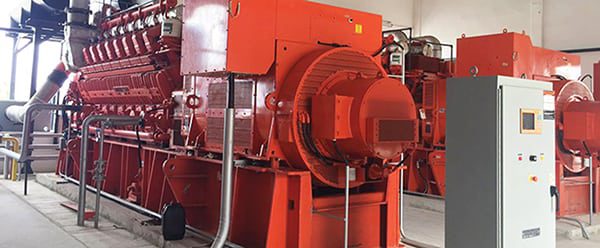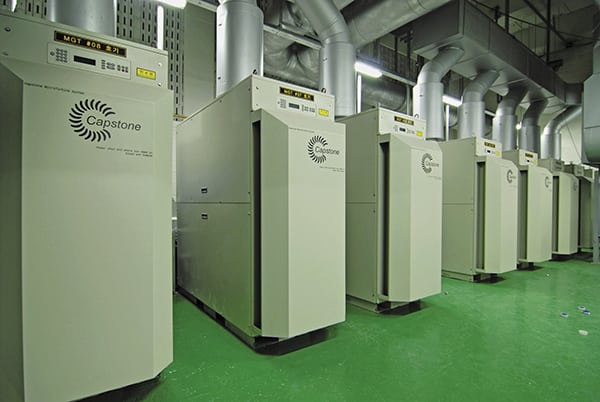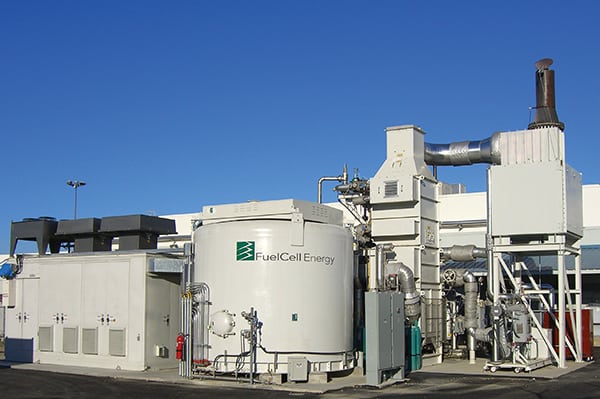Gas-Fired DG Showdown: Microturbines, Fuel Cells, or Reciprocating Engines?
If you’re looking to generate distributed power with gas, your options are broader than ever, with a range of efficient, clean-burning technologies to chose from. Knowing which option is the right one depends on a balance of site constraints, fuel supplies, and environmental oversight.
When California State University San Marcos (CSUSM), a 14,000-student university north of San Diego, needed to upgrade its campus generation, it was faced with several dilemmas. Strict state emissions regulations, especially along the coast, meant that choosing the traditional institutional standby—a fuel oil– or gas-fired boiler—would be problematic. State agencies have also been called upon to substantially reduce their water usage as the state struggles with a record drought.
In years past, the university would have had relatively few options. Today, however, things have changed. Rather than take the traditional route, the school chose an option that would have seemed fanciful only a few years ago: fuel cells.
Working with Biofuels Energy, which will install two 440-kW Doosan fuel cells and sell the power to the school under a power purchase agreement, CSUSM cut its reliance on the local grid and reduced its water consumption and carbon emissions.
“As an institution for higher learning, we believe it is our responsibility to continually look for the most efficient and innovative ways we can operate our campus,” Lindsey Rowell, director of energy management and utility services for the school said. “CSUSM’s new fuel cells not only represent a significant step toward achieving our aggressive sustainability goals, they will also offset electricity costs and ensure we can sustain continued growth while remaining one of the most energy-efficient universities in the state.”
The fuel cell plant will also drive a 90-ton chiller, which means Biofuels Energy will also provide chilled and hot water at the campus. CSUSM said that transitioning to fuel cell generation will result in a net 2.5 million gallon reduction in its water consumption compared to relying on utility generation. The $8 million project benefited from the Investment Tax Credit and California’s Self Generation Incentive Program (SGIP).
CSUSM is not the first Cal State campus to rely on fuel cells—several others in Southern California and the Bay Area have similar power plants for on-campus generation.
Distributed generation (DG), once the province of boilers and diesel generators, has seen a substantial expansion of its options in recent years, including 100% renewable energy such as rooftop solar panels and wind turbines (see “Outside-the-Box Renewable Energy Microturbines” in this issue). But for entities needing on-demand power, gas-fired options have emerged as some of the most competitive because of their efficiency, low fuel costs, and low emissions. That’s meant that gas-fired reciprocating engines, microturbines, and fuel cells are snatching up an increasing share of the DG mix.
Microturbines: Pocket Powerhouses
Microturbines have been around for years, but the market is growing as concerns about emissions and environmental regulations grow, Jim Crouse, executive vice president of sales and marketing for Capstone Turbine told POWER.
“In choosing our technology, decisions tend to be around the overall environmental footprint that we provide versus other options, given its low emissions without any exhaust after-treatment,” he said. “The more stringent your emissions regulations become, the more it lends itself to microturbine technology, which is cleaner than combustion engines.”
Microturbines are also a popular option for small combined heat and power (CHP) applications, Crouse said. With federal and state-level programs promoting CHP, and trade associations raising awareness of CHP’s efficiency advantages, “the market is good.” Crouse said Capstone is seeing growing interest at the institutional level, with hospitals and large hotels opting for microturbines over other options. (For more on CHP trends, see “Global CHP Still Struggling to Break Out of Its Niche” in the February 2015 issue.)
Microturbines also offer smaller footprints and lower noise and vibration profiles than reciprocating engines, Crouse explained (Figure 1). “It’s not that engines can’t be accommodated, but as you incorporate enclosures or isolations into the project, it can get expensive.”
A recent report from financial analysis firm Future Market Insights predicts that the global microturbine market will double by 2020, driven by the technology’s efficiency, flexibility, and low emissions. Most of the growth is expected in North America and Europe, where tightening emissions regulations make microturbines an attractive alternative to traditional gensets, the report says.
One good example of what microturbines can offer is found in a project Capstone delivered to a luxury ski resort in southern Chile in 2013. The site is in the middle of a sensitive nature preserve, meaning the developers had to be mindful of their impact on the surrounding area. The nearest grid connection was six miles away, so relying on grid power would have been expensive and would have required additional development within the preserve to build the transmission lines.
Instead, the resort opted for four Capstone C65 microturbines fired by propane and equipped with waste heat recovery. The system produces 200 kW of electric and 400 kW of thermal energy, meeting all the resort’s heating and hot water needs. The low noise emissions and absence of exhaust odors maintain the high-end resort’s luxury ambience as well as minimizing impact on the nature preserve. The system’s intelligent automation, low maintenance requirements, and reliability are also plusses for a site that is 75 miles from the nearest town.
Fuel Cells: New Kids on the Block
The technology behind fuel cells, which generate electricity through chemical reactions with hydrogen or methane rather than by way of combustion, has been understood for many years—and over-hyped more than once—but only recently did it become cost-competitive with other options. The fall in natural gas prices and tightening emissions regulations have also offered a big boost to companies marketing fuel cell generation.
The U.S. market has been dominated by two companies: Silicon Valley–based Bloom Energy, which has focused on smaller DG applications, and Danbury, Conn.–based FuelCell Energy (FCE), which has aimed at larger deployments. Korean firm Doosan Corp. moved into the market last year when it bought ClearEdge Power to form the Doosan Fuel Cell Group with the acquisition of a Korean fuel cell firm. ClearEdge Power’s 400-kW fuel cell design will be used for the CSUSM project.
Fuel cells come with many of the same advantages of microturbines, though their emissions are even lower, low enough to qualify for subsidies that support low-emission generation in some states, including California. Fuel cells generate almost no NOx, SOx, or particulate matter, and substantially less carbon dioxide per kilowatt-hour compared to combustion-based generation. They can also be used in CHP applications, since the fuel cell process generates sufficient waste heat (Figure 2). Fuel cells are also typically more efficient than combustion turbines and reciprocating engines.
These advantages have drawn substantial interest and investment from utilities and generators. Last year, NRG expanded its small stake in FCE with an additional $35 million investment. NRG also established a $40 million revolving construction and term loan facility for FCE to use for project development. The deal will give NRG a 6% stake, while the credit facility will make it easer for FCE to develop new projects and sell finished plants to long-term investors.
Meanwhile, Exelon has entered into a series of agreements with Bloom Energy to deploy up to 40 MW of the company’s fuel cells—roughly 170 small-scale projects—for Exelon customers in California, Connecticut, New Jersey, and New York.
Fuel cells are being deployed in the sorts of applications once taken by reciprocating engines. For example, the Gills Onions processing plant in Oxnard, Calif., uses a two-cell, 600-kW system supplied by FCE. The facility runs off biogas generated from onion waste in an anaerobic digester. FCE has developed a number of other biogas-powered projects, most recently a 1.4-MW plant in Riverside, Calif., that will be installed at the city’s wastewater treatment plant.
But the Riverside project illustrates one potential hurdle for fuel cell generation, which so far depends on a favorable regulatory environment to compete. The city determined that fuel cells were the cheaper option compared to reciprocating engines—but that was largely because using the latter would still entail compliance costs under Southern California’s strict emissions regulations. Using fuel cells allowed the city to eliminate those compliance obligations.
In addition, the regulatory environment is showing signs of shifting against fuel cells powered by fossil fuels. California is reconsidering the carbon dioxide limits for generation under the SGIP, and there has been pressure from lawmakers and environmental groups to push those limits low enough to eliminate fuel cells powered by natural gas, though biogas-powered fuel cells like those at CSUSM and Riverside would likely still qualify.
Reciprocating Engines: Dependable Workhorses
Gas-fired reciprocating engines have gotten a major boost this decade because of plummeting natural gas prices, which have given them a competitive edge against diesel gensets (see “Diesel Gensets Aim at the Future” in this issue). And despite competition from microturbines and fuel cells, they remain a solid option because of their rugged reliability and low costs where strict emissions controls are less of a concern.
GE’s Waukesha line of gas-fired gensets have been a staple of the natural gas industry for decades because of their ability to operate on a wide variety of fuels, including hot field gases, and to provide reliable service at altitudes that would challenge other technologies. (For more on generation with reciprocating engines, see “Reciprocating Engines Expand Roles” in the September 2014 issue.)
These advantages are especially relevant in the developing world, where fuel supplies may be uncertain and technical support limited. GE recently supplied four Waukesha gensets (three 275GL+ and one VHP 7104GSI) to power the Lekki Free Zone (LFZ) near Lagos, Nigeria (Figure 3). The Nigerian government hopes to make the LFZ the largest free-trade commercial, logistics, and manufacturing hub in West Africa. Making that happen in a country with an unreliable national grid (see “Nigeria Has Gas Capacity, Gas Supply, but Little Gas Power” in the July 2015 issue) means rock-solid DG is necessary.
 |
| 3. Power for trade. These GE Waukesha gas-fired gensets are powering the Lekki Free Zone in Nigeria, where the nation hopes to set up a regional trade hub. Courtesy: GE |
“The future of the Lekki Trade Zone is essential to Nigeria’s growth as West Africa’s economic driver,” said LFZ Manager Omodele Doherty. “We cannot accomplish our expansion goals without a reliable source of continuous power.” The LFZ opted for Waukesha gensets because of their wide fuel flexibility and ability to run on compressed natural gas and propane. Their low emissions compared to fuel oil or diesel also factored into the decision.
Landfill gas (LFG) and other biogases remain a common DG application for reciprocating engines, again because of their tolerance for fuel variations. When the U.S. Environmental Protection Agency recognized its 2014 projects of the year honoring excellence in renewable energy using LFG, all three relied on Caterpillar gas-fired reciprocating engines. These ranged from a 17.6-MW project in New York to a 3.2-MW facility in Ohio.
“Current fuel treatment and engine-generator technologies help put landfill gas-to-energy projects in a highly attractive and environmentally friendly position,” said Caterpillar’s Paul Zink in a statement in May. “These projects demonstrate just how valuable biogas has become and how leading companies are now taking advantage of advanced renewable energy technologies.”
Whatever your distributed generation needs, the boom in gas-fired power is providing more options than ever before. ■
—Thomas W. Overton, JD is a POWER associate editor.

